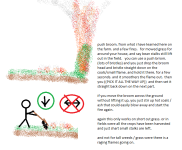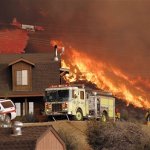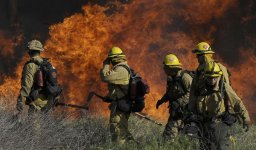schmism
Super Member
lets be clear ...brush fire fighting and structure fire fighting are entirely diffrent.
do not confuse the min requirements for structure fire fighting with that of wildland firefighting.
The following list is presented in smallest to largest (size /heat out put of wildland firefighting)
-protective gear. long pants (carhart- denim... not zip off plastic REI hikeing pants), a leather winter jacket, face shield, wristed leather gloves.
a flat shovel is a good first tool to attack small short grass fires.
an upgrade is a flapper, aka a hunk of semi-mudflap bolted to the end of a shovel handle.
A flapper can be effectivly used in med tall thick grass although takes effort and good protective gear.
backpack sprayer or Indian pack. generally tall thick grass is to hot to work with mechanical methods, but even a small spritz of water will quickly knock down the grass fire. the standard backpack sprayer can cover 300+ feet of flame front when working with another person.
From here you can step up to a 20 gal sprayer on the back of a atv/utv 12v powered, covers 4-5 times the space as a backpack
and from that to a large 200+ gal tank on the back of a truck/tractor with a 1" hose and pump capable of 60psi.
The point is if your out with the brush pile, and watching things, small hot spots can be put out quickly with minimal tools before they turn into mulipul acer fires.
do not confuse the min requirements for structure fire fighting with that of wildland firefighting.
The following list is presented in smallest to largest (size /heat out put of wildland firefighting)
-protective gear. long pants (carhart- denim... not zip off plastic REI hikeing pants), a leather winter jacket, face shield, wristed leather gloves.
a flat shovel is a good first tool to attack small short grass fires.
an upgrade is a flapper, aka a hunk of semi-mudflap bolted to the end of a shovel handle.
A flapper can be effectivly used in med tall thick grass although takes effort and good protective gear.
backpack sprayer or Indian pack. generally tall thick grass is to hot to work with mechanical methods, but even a small spritz of water will quickly knock down the grass fire. the standard backpack sprayer can cover 300+ feet of flame front when working with another person.
From here you can step up to a 20 gal sprayer on the back of a atv/utv 12v powered, covers 4-5 times the space as a backpack
and from that to a large 200+ gal tank on the back of a truck/tractor with a 1" hose and pump capable of 60psi.
The point is if your out with the brush pile, and watching things, small hot spots can be put out quickly with minimal tools before they turn into mulipul acer fires.






![burn pile[1].jpeg burn pile[1].jpeg](https://www.tractorbynet.com/forums/data/attachments/253/253406-9085f419bc149513e5e13a3236cda047.jpg)
